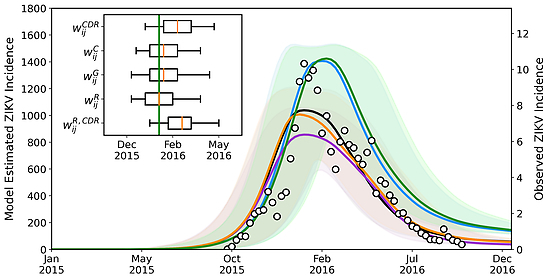Arbeitsbereich
Migration und Mobilität
Auf einen Blick
Projekte
Publikationen
Team
Projekt
Impact of Human Mobility on Spatial Dynamics of Infectious Diseases
Daniela Perrotta, Egor Kotov; in Zusammenarbeit mit John Palmer (Pompeu Fabra University, Barcelona, Spanien), Frederic Bartumeus (The Spanish National Research Council, Blanes Centre for Advanced Studies, Spanien)
This project leverages various sources of human mobility at different scales, both from digital traces and mobile phone activities, in order to understand better their impact on modeling the spatial spread of infectious diseases. Ausführliche Beschreibung
Menschliche Mobilität und der Ausbruch des Zika-Virus in Kolumbien

Vergleich von der ZIKV Inzidenz (pro 100.000 Einwohner) wie von der amtlichen Überwachung gemeldet (schwarze Punkte) und verschiedenen Netzwerken © Perrotta, D., Frias-Martinez, E., Piontti, A. P. y, Zhang, Q., Luengo-Oroz, M., Paolotti, D., Tizzoni, M., & Vespignani, A. (2022). Comparing sources of mobility for modelling the epidemic spread of Zika virus in Colombia. PLOS Neglected Tropical Diseases, 16(7), Article 7. https://doi.org/10.1371/journal.pntd.0010565
Das Diagramm zeigt den Vergleich zwischen der ZIKV-Inzidenz (pro 100.000 Einwohner), wie sie von der amtlichen Überwachung gemeldet wird (schwarze Punkte), und den Schätzungen des stochastischen Ensemble-Outputs für jedes betrachtete Mobilitätsnetzwerk, d. h. das CDR-informierte Netzwerk (blau), das Zensusnetzwerk (schwarz), das Schwerkraftnetzwerk (orange), das Strahlungsnetzwerk (violett) und das auf CDR-informierte Mobilität kalibrierte Strahlungsnetzwerk (grün).
Das eingefügte Diagramm zeigt die anhand der Modellschätzungen berechnete Spitzenwoche im Vergleich zur beobachteten Spitze in der Woche 2016-05 (grüne Linie). Während die Leistung der verschiedenen Mobilitätsnetzwerke auf nationaler Ebene vergleichsweise ähnlich ist, zeigt die Abbildung die gute Leistung unseres Modells, einschließlich seiner epidemiologischen Annahmen, bei der Erfassung der Ausbruchsdynamik ohne jegliche Anpassung an die beobachteten Daten. Weitere Einzelheiten sind in der Veröffentlichung zu finden.
Publikationen
Kotov, E.; Lovelace, R.; Vidal-Tortosa, E.:
Software. The Comprehensive R Archive Network: CRAN. (2025)
Perrotta, D.; Frias-Martinez, E.; Pastore y Piontti, A.; Zhang, Q.; Luengo-Oroz, M.; Paolotti, D.; Tizzoni, M.; Vespignani, A.:
PLOS Neglected Tropical Diseases 16:7, e0010565–e0010565. (2022)

Perrotta, D.; Frias-Martinez, E.; Pastore y Piontti, A.; Zhang, Q.; Luengo-Oroz, M.; Paolotti, D.; Tizzoni, M.; Vespignani, A.:
medRxiv preprints. unpublished. (2021)
